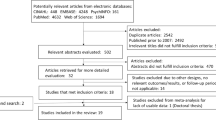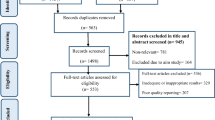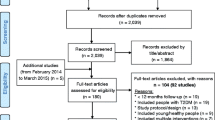Abstract
Background
Map** the available evidence can be used to inform current diabetes research, identify relevant gaps, and prioritize future research. In this regard, we mapped diabetes research performed in Iran.
Method
We searched the Scopus and PubMed databases from 01/01/2015 till 01/01/2020 using keywords such as diabetes and Iran. The included articles were classified according to their document types, level of evidence, and subject areas.
Results
The majority of the included articles (53%) were related to diabetes types, followed by complications (28%). Most of the documents were original articles (82%), and reviews were 18% of the publications. Systematic reviews constitute only 6% of the total documents. Observational studies were the most common types of study designs (26%), followed by clinical trials (20%). Moreover, topics on control and management of diabetes were the most prevalent subject areas (58%), and fewer studies were on preventive strategies (6%). In diabetes management studies, less attention has been paid to evaluate psychological (10%), educational (9%), and physical activity-related (7%) interventions. There was a shortage of secondary studies related to physical activity, psychology, diagnostic, and screening-related studies.
Conclusion
To fill diabetes research gaps, more investment in cost-effectiveness interventions, such as preventive strategies and behavioral self-management programs, need. Moreover, we need to pay more attention on applied sciences and real world evidence to bridge translational gaps from bench to bedside. In this regard, further data synthesis can be helpful in evaluating the effectiveness of the available studies and avoiding unnecessary investigations.







Similar content being viewed by others
Data availability
All data generated or analysed during this study are included in this published article [and its supplementary information files].
References
Federation, I.D.J.D.I., IDF diabetes atlas ninth. 2019.
Federation I. International diabetes Federation. In: IDF Diabetes Atlas. 8th ed. Brussels: International Diabetes Federation; 2017.
Esteghamati A, et al. Diabetes in Iran: prospective analysis from first Nationwide diabetes report of National Program for prevention and control of diabetes (NPPCD-2016). Sci Rep. 2017;7(1):13461.
Brownlee M. The pathobiology of diabetic complications. A unifying mechanism. Diabetes. 2005;54(6):1615–25.
Glasgow RE. Translating research to practice. Lessons learned, areas for improvement, and future directions. Diabetes Care. 2003;26(8):2451–6.
Pound P, Ritskes-Hoitinga M. Can prospective systematic reviews of animal studies improve clinical translation? J Transl Med. 2020;18(1):15.
Geiss L, et al. A national progress report on diabetes: successes and challenges. Diabetes Technol Ther. 2005;7(1):198–203.
Fonseca VA, et al. The American Diabetes Association diabetes research perspective. Diabetes Care. 2012;35(6):1380–7.
Chalmers I, et al. How to increase value and reduce waste when research priorities are set. Lancet. 2014;383(9912):156–65.
Bloomfield GS, et al. Disparities in cardiovascular research output and citations from 52 African countries: a time-trend, bibliometric analysis (1999-2008). J Am Heart Assoc. 2015;4(4):e001606.
Grant MJ, Booth AJHI, Journal L. A typology of reviews: an analysis of 14 review types and associated methodologies. Health Inf Libr J. 2009;26(2):91–108.
Bragge P, et al. The global evidence map** initiative: sco** research in broad topic areas. BMC Med Res Methodol. 2011;11:92. https://doi.org/10.1186/1471-2288-11-92.
Chalmers I, Glasziou P. Avoidable waste in the production and reporting of research evidence. Lancet. 2009;374(9683):86–9.
O’Leary BC, et al. Evidence maps and evidence gaps: evidence review map** as a method for collating and appraising evidence reviews to inform research and policy. Environ Evid. 2017;6(1):19.
Sun Y, et al. Evidence map** of recommendations on diagnosis and therapeutic strategies for diabetes foot: an international review of 22 guidelines. Metabolism. 2019;100:153956.
Sun Y, et al. An evidence map of clinical practice guideline recommendations and quality on diabetic retinopathy. Eye (Lond). 2020;34(11):1989–2000.
Correia JC, et al. Interventions targeting hypertension and diabetes mellitus at community and primary healthcare level in low- and middle-income countries:a sco** review. BMC Public Health. 2019;19(1):1542.
Kullgren JT, et al. A sco** review of behavioral economic interventions for prevention and treatment of type 2 diabetes mellitus. Curr Diab Rep. 2017;17(9):73.
Rosputni C, et al. Diabetes prevention programs in rural North America: a systematic sco** review. Curr Diab Rep. 2019;19(7):43.
Khosravi B, et al. Health care expenditure in the Islamic Republic of Iran versus other high spending countries. Med J Islam Repub Iran. 2017;31:71.
Hetrick SE, et al. Evidence map**: illustrating an emerging methodology to improve evidence-based practice in youth mental health. J Eval Clin Pract. 2010;16(6):1025–30.
Katz DL, et al. The evidence base for complementary and alternative medicine: methods of evidence map** with application to CAM. Altern Ther Health Med. 2003;9(4):22–30.
Arksey H, O'Malley L. Sco** studies: towards a methodological framework. Int J Soc Res Methodol. 2005;8(1):19–32.
Süt N. Study designs in medicine. Balkan Med J. 2014;31(4):273–7.
Moher D, et al. Preferred reporting items for systematic reviews and meta-analyses: the PRISMA statement. BMJ (Clinical research ed). 2009;339:b2535.
Saran A, White H. Evidence and gap maps: a comparison of different approaches. Campbell Syst Rev. 2018;14(1):1–38.
Miake-Lye IM, et al. What is an evidence map? A systematic review of published evidence maps and their definitions, methods, and products. Syst Rev. 2016;5(1):28.
Afable A, Karingula NS. Evidence based review of type 2 diabetes prevention and management in low and middle income countries. World J Diabetes. 2016;7(10):209–29.
Timpel P, et al. Map** the evidence on the effectiveness of telemedicine interventions in diabetes, dyslipidemia, and hypertension: an umbrella review of systematic reviews and Meta-analyses. J Med Internet Res. 2020;22(3):e16791.
Wang DD, et al. Creating a literature database of low-calorie sweeteners and health studies: evidence map**. BMC Med Res Methodol. 2016;16(1):1.
Singh K, et al. An evidence map of systematic reviews to inform interventions in prediabetes. Can J Diabetes. 2012;36(5):281–91.
Patsopoulos NA, Analatos AA, Ioannidis JPJJ. Relative citation impact of various study designs in the health sciences. Jama. 2005;293(19):2362–6.
Schlosser RW. The role of systematic reviews in evidence-based practice, research, and development. Focus. 2006;15:1–4.
Bärnighausen T, et al. Quasi-experimental study designs series—paper 4: uses and value. J Clin Epidemiol. 2017;89:21–9.
Kaptchuk TJ. The double-blind, randomized, placebo-controlled trial: gold standard or golden calf? J Clin Epidemiol. 2001;54(6):541–9.
Pandis N. The evidence pyramid and introduction to randomized controlled trials. Am J Orthod Dentofac Orthop. 2011;140(3):446–7.
Frieden TR. Evidence for health decision making — beyond randomized, controlled trials. N Engl J Med. 2017;377(5):465–75.
Ali Z, Chandrasekera PC, Pippin JJ. Animal research for type 2 diabetes mellitus, its limited translation for clinical benefit, and the way forward. Altern Lab Anim. 2018;46(1):13–22.
Chatzigeorgiou A, et al. The use of animal models in the study of diabetes mellitus. In vivo. 2009;23(2):245–58.
Knowler WC, et al. Reduction in the incidence of type 2 diabetes with lifestyle intervention or metformin. N Engl J Med. 2002;346(6):393–403.
Kirkman MS, et al. Impact of a program to improve adherence to diabetes guidelines by primary care physicians. Diabetes Care. 2002;25(11):1946–51.
Cooksey D, A review of UK health research funding. 2006: The Stationery Office.
Zaccardi F, Davies M, Khunti K. The present and future scope of real-world evidence research in diabetes: what questions can and cannot be answered and what might be possible in the future? Diabetes Obes Metab. 2020;22:21–34.
Evans K. Real world evidence: can we really expect it to have much influence? Drugs Real World Outcomes. 2019;6(2):43–5.
Curtis HJ, et al. Time trends and geographical variation in prescribing of drugs for diabetes in England from 1998 to 2017. Diabetes Obes Metab. 2018;20(9):2159–68.
Ueda P, et al. Sodium glucose cotransporter 2 inhibitors and risk of serious adverse events: nationwide register based cohort study. Bmj. 2018;363:k4365.
Nasli-Esfahani E, et al. Iran diabetes research roadmap (IDRR) study: a preliminary study on diabetes research in the world and Iran. J Diabetes Metab Disord. 2017;16:9.
Klaprat N, MacIntosh A, McGavock JM. Gaps in knowledge and the need for patient-Partners in Research Related to physical activity and type 1 diabetes: a narrative review. Front Endocrinol. 2019;10(42).
Codella R, Terruzzi I, Luzi L. Why should people with type 1 diabetes exercise regularly? Acta Diabetol. 2017;54(7):615–30.
American Diabetes Association. 8 obesity Management for the Treatment of type 2 diabetes: standards of medical Care in Diabetes—2020. Diabetes Care. 2020;43(Supplement 1):S89–97.
Colberg SR, et al. Physical activity/exercise and diabetes: a position statement of the American Diabetes Association. Diabetes Care. 2016;39(11):2065–79.
Chatterjee S, Davies MJ. Current management of diabetes mellitus and future directions in care. Postgrad Med J. 2015;91(1081):612–21.
Ali MK, Echouffo-Tcheugui J, Williamson DF. How effective were lifestyle interventions in real-world settings that were modeled on the diabetes prevention program? Health Aff (Millwood). 2012;31(1):67–75.
Johnson M, et al. Can diabetes prevention programmes be translated effectively into real-world settings and still deliver improved outcomes? A synthesis of evidence. Diabet Med. 2013;30(1):3–15.
Diabetes Prevention Program Research Group. Impact of intensive lifestyle and metformin therapy on cardiovascular disease risk factors in the diabetes prevention program. Diabetes Care. 2005;28(4):888–94.
Kolb H, Martin S. Environmental/lifestyle factors in the pathogenesis and prevention of type 2 diabetes. BMC Med. 2017;15(1):131.
Florez H, et al. Impact of lifestyle intervention and metformin on health-related quality of life: the diabetes prevention program randomized trial. J Gen Intern Med. 2012;27(12):1594–601.
Zhuo X, et al. A nationwide community-based lifestyle program could delay or prevent type 2 diabetes cases and save $5.7 billion in 25 years. Health Aff. 2012;31(1):50–60.
Felton A-M and Hall M, Diabetes in Europe policy puzzle: the state we are in. 2015, Taylor & Francis.
Funding
This research received a grant (grant number:1398-1-97-974) from Endocrinology and Metabolism of Research Institute, Tehran University of Medical Sciences.
Author information
Authors and Affiliations
Contributions
SH.E: the data collection and extraction, thematic synthesis of information, the data classification, write the manuscript draft, revised it, and approved final manuscript.
F.R, N.N, M.S., M.A, F.B,, A.T, S.S, C.R: the data screening.
F.GH, B.E, SH.H: the data extraction.
N.F, F.B: critically reviewed the manuscript.
B.L: provided the study concept and critically reviewed the manuscript and approved final manuscript.
E.N-E: provided the study concept and critical review of the manuscript and approving final manuscript.
Corresponding authors
Ethics declarations
Ethics approval and consent to participate
Not applicable.
Consent for publication
Not applicable.
Competing interests
The authors declare no competing interests.
Ethics approval
This study was approved by the ethical committee of Tehran University of Medical Sciences (IR.TUMS.EMRIREC. 1399.004).
Additional information
Publisher’s note
Springer Nature remains neutral with regard to jurisdictional claims in published maps and institutional affiliations.
Rights and permissions
About this article
Cite this article
Esmaeili, S., Bandarian, F., Gharishvandi, F. et al. Knowledge gaps in diabetes research: an evidence map** of the literature. J Diabetes Metab Disord 21, 1139–1148 (2022). https://doi.org/10.1007/s40200-022-01037-9
Received:
Accepted:
Published:
Issue Date:
DOI: https://doi.org/10.1007/s40200-022-01037-9




